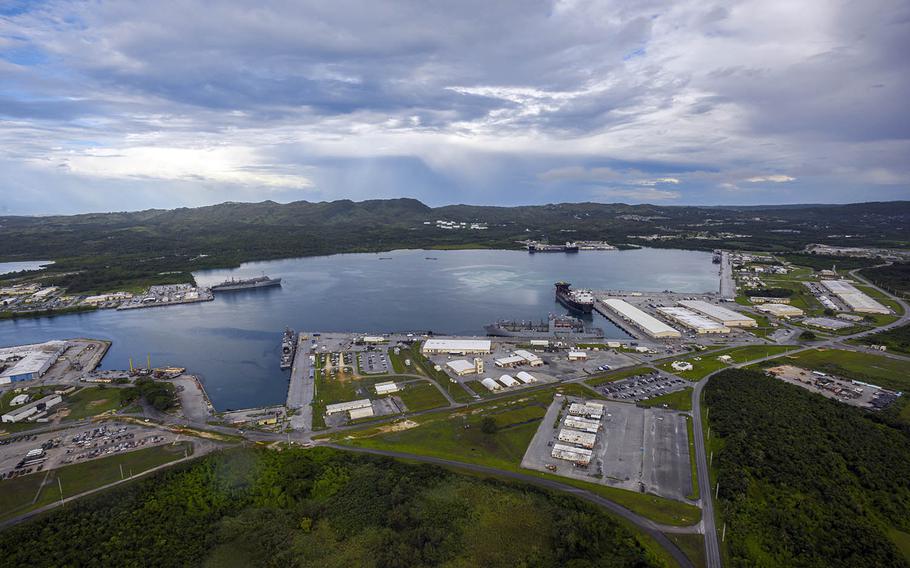
This aerial view of Naval Base Guam shows Apra Harbor with several Navy vessels in port, Aug. 24, 2020. (MacAdam Kane Weissman/U.S. Navy)
The head of U.S. Indo-Pacific Command sees one overriding and essential first step in deterring China’s military expansion in the Pacific.
“Funding for the air and missile defense of Guam is my No. 1 priority,” Adm. Philip Davidson said Thursday during a virtual talk hosted by the American Enterprise Institute, a Washington D.C.-based think tank.
“Guam is absolutely critical in maintaining deterrence and stability in the region,” he said. “It’s our most critical operating location west of the International Date Line.”
The U.S. territory is “a critical nexus for command and control, for logistics and sustainment and for our power projection,” Davidson said. The small island is home to a deep-water port, Naval Base Guam and Andersen Air Force Base.
The best means of protecting the island is the “highly capable, adaptable and proven” Aegis Ashore missile defense system, which defends against short- to intermediate-range ballistic missiles, he said.
The $1.6 billion Aegis Ashore system tops the list Davidson submitted to Congress this week in his assessment of warfighting resources needed under the Pacific Deterrence Initiative, which was created a year ago and aimed toward China.
The assessment, which looks out five years, was required by the 2021 National Defense Authorization Act that passed in January. It requests $4.68 billion for fiscal year 2022 and another nearly $23 billion for the five years through fiscal year 2027.
“We took an approach that concentrated on the investments that were absolutely needed out here from a joint-integration perspective,” Davidson told the virtual audience from his headquarters in Honolulu, where he has commanded since 2018. He will step down from the position later this year.
Aegis Ashore would bring the same defensive capabilities to Guam as are now being provided by three Navy guided-missile destroyers, Davidson said.
“We need to free up those guided-missile destroyers who have multi-mission capability to detect threats and finish threats under the sea, on the sea and above the sea,” he said.
Untethered from Guam, those destroyers will move with the Navy forces they were designed to protect from ballistic missile attack in the first place, Davidson said.
A Guam-based Aegis would become part of the joint-force network being developed in the Pacific whose goal is to give commanders flexibility in using fire power by any of the services whether on land, sea or air.
Compared to the measured remarks about China that Davidson offered up when he took command three years ago, he is now blunt in his assessment.
“The most important thing I’d like you all to take away from the discussion is a fundamental understanding that the period between now and 2026 — this decade — is the time horizon in which China is positioned to achieve overmatch in its capability and when Beijing could — could — likely choose to forcibly change the status quo in the region,” Davidson said in his opening remarks. “And I would say the change in that status quo could be permanent.
Davidson dismissed fears over how China would respond to Aegis Ashore on Guam.
“Placing a fixed defense system on Guam does not make Guam a target — it is already one,” he said. “China is making no secret of this fact, as evidenced in last fall’s widely circulated [People’s Liberation Army] air force propaganda video which explicitly depicted an attack on a mock-up of Andersen Air Force Base on Guam.”
Ultimately, Guam should not be regarded as an island “we only need to be able to fight from,” he said.
“We’re going to have to be able to fight for it, and missile defense in the region is critical,” he said.
olson.wyatt@stripes.com Twitter: @WyattWOlson